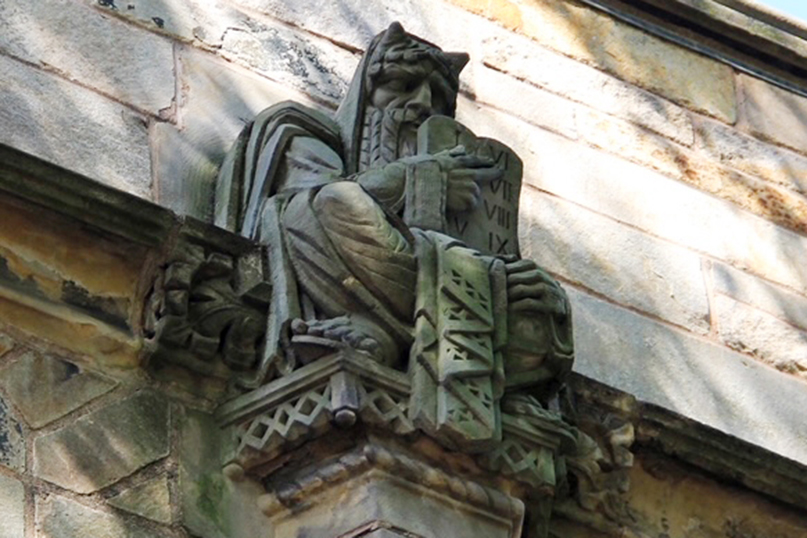
By Jonathan Harounoff and Stephanie Posner
(JNS) Antisemitic and racist graffiti found on the Yale University campus in recent weeks has made New Haven less of a haven for the community’s Jewish population. And these weren’t isolated incidents.
In less than two years, synagogues have been ransacked, false bomb threats have been made to Jewish community centers and a Chabad rabbi was robbed and beaten outside his own synagogue.
Exactly two years ago, antisemitic graffiti was found scrawled on the steps of Yale Law School. Arrests were made and a statement of solidarity was issued by Yale president Peter Salovey, who reaffirmed his commitment to “fostering a diverse and inclusive community.”
Such statements can often seem like just that—statements. Meaningful change won’t come until real action is taken. Yale can start by addressing an offensive, century-old piece of architecture on one of the school’s most iconic buildings that has eluded serious scrutiny.
Cross campus is the beating heart of Yale’s student universe. In a pre-pandemic world, the campus quad would be perennially overrun by streams of students and sightseers.
Flanking the quad is the university’s sprawling gothic centerpiece, Sterling Memorial Library, home to more than 2.5 million books and some 3,300 stained-glass windows. Nestled atop one corner of the library are 15 buttresses that, according to a 1930 Yale University Library Gazette article, are “figures representative of the fields of knowledge covered by the classification of the contents of the library.”
Socrates is perched up there to represent the study of philosophy; Shakespeare for literature; Bach for music; Newton for physics; Leonardi da Vinci for fine arts; Adam Smith for economics; and Moses for religion. Great idea, right?
The problem is that the university’s Moses, clutching the Ten Commandments, has horns protruding from his head. And the library walls—the university’s symbol of knowledge and truth—offer no explanation why this is so.
Antisemitic attacks in New Haven are not, of course, a result of the horned Moses, but if Yale wants to demonstrate its commitment to fostering a hatred-free campus beyond disseminating pre-packaged statements of dismay and unity, it should start by looking in the mirror.
The university has had ample opportunity to address the horned Moses—not necessarily by removing it, but at least by offering a historical context to remind passers-by that Jewish men don’t, in fact, cover their heads with a kippah to keep their horns at bay.
One of the university’s committees is even called the Committee on Art in Public Spaces, established to advise the president about the “numerous works of art situated in Yale’s public spaces,” but Moses didn’t seem to make the cut.
The best-known rendering of a horned Moses is Michelangelo’s 16th-century statue, now sitting in Rome’s Church of San Pietro in Vincoli as part of Pope Julius II’s mausoleum. The horns of Moses have traditionally been explained as a result of a mistranslation by St. Jerome, who interpreted the Hebrew word keren as “horn,” rather than “ray of light.”
“When Moses came down from Mount Sinai with the two tablets of the covenant law in his hands, he was not aware that his face was radiant because he had spoken with the Lord.”
“I was naïve to think that the last place I would see a millennium-long antisemitic depiction of Moshe would be on the Yale campus crown jewel, Sterling Memorial Library,” said Cameron Frostbaum, a Yale theater management student, currently on leave to study in Jerusalem, who noticed the statue while walking through campus.
He added that the “easy thing to do would be to have the statue altered or taken down. But this is a part of Yale’s history that people should be aware of as we see Jewish people experiencing harassment and antisemitic incidents at alarming rates all over the United States, and specifically in New Haven.”
Yale has in the past altered some of its contentious architecture. In 2017, the university concealed part of a stone carving outside Yale’s Sterling Library that showed a Puritan man pointing a gun at a Native American’s head. But expunging history isn’t exactly the best tool for remembering egregious forms of bigotry.
For Meir Chaim Posner, a Yale Chabad rabbi whose colleague, Shua Rosenstein, was beaten and robbed outside the Chabad shul in April 2020, the inconsistency in how Yale has dealt with problematic art or architecture on campus is the key point of contention.
“There’s an important need to provide context to those depictions and the antisemitic tropes they propagate,” said Posner, who bears no relation to the author, adding that he’s “not in the camp that supports removing the Moses in question, but does condemn the fact that it’s ignored.”
Stephen Bertman, professor emeritus of languages, literature and culture at the University of Windsor in Canada, also noted: “These works of art should be preserved—as long as a conscious effort is made to inform the viewer about any lies they might otherwise perpetuate. Such works of art that distort history should be accompanied by captions or commentaries that anticipate and serve to correct the initial and incorrect impressions that an uninformed viewer may come away with.”
In response to calls to demolish Nelson’s Column in London because he supported slavery, Sir Roy Strong, art historian and former director of the Victoria and Albert Museum, wrote in a 2017 Times of London column, “Once you start rewriting history on that scale, there won’t be a statue or a historic house standing … The past is the past. You can’t rewrite history.”
History and architecture can be powerful reminders of human flaws, and the best history lessons can often be drawn by some of the past’s most nefarious characters. Removing a significant part of Yale’s history doesn’t necessarily serve a purpose, and it certainly does little to prevent the continuation of Jew-hatred. However, the decorative Moses at Yale is not a historical monument, nor is it displayed in a museum where there is an opportunity for explanation.
Yale is not the only U.S. university to house bedeviled depictions of Moses. A towering statue of a horned Moses, with his index finger pointing upwards to indicate that there’s only one God, also sits outside of the University of Notre Dame’s Hesburgh Library, despite claims by undergraduate students that the statue, which also isn’t adequately contextualized, has helped perpetuate antisemitic tropes across campus.
Large, crooked noses and horns are features that antisemites have classically attributed to Jews. Such features were regularly used by Nazis in the 1930s to demonize Jews. And more recently, in 2019, antisemitic fliers featuring Jewish men with enlarged noses and horns were found throughout Newton, Massachusetts, allegedly distributed by far-right, neo-Nazi group The Daily Stormer.
Yale, like Notre Dame, should do better if they truly want to create a campus culture devoid of all forms of hatred.
Jonathan Harounoff, a former New Haven resident, is a British analyst and journalist based in New York City. He is also a graduate of Columbia Journalism School and an alumnus of the Universities of Cambridge and Harvard.
Stephanie Posner is a policy professional and recent master’s student at the Yale University School of Management and Jackson Institute of Global Affairs. She is also a former Kennedy Scholar at Harvard University and holds a BA in Classics from Cambridge University.
Main Photo: Yale University’s Sterling Memorial Library, with a statue of Moses with horns protruding from his head. Credit: Karyn Bell.








 Southern New England Jewish Ledger
Southern New England Jewish Ledger













